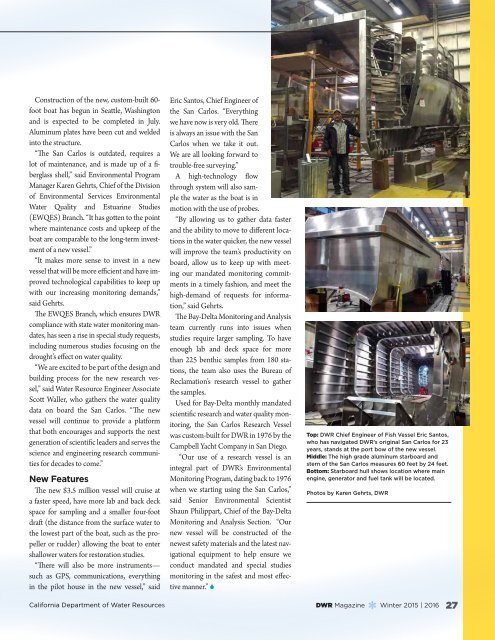Restored
dwr_mag_w16
dwr_mag_w16
Create successful ePaper yourself
Turn your PDF publications into a flip-book with our unique Google optimized e-Paper software.
Construction of the new, custom-built 60-<br />
foot boat has begun in Seattle, Washington<br />
and is expected to be completed in July.<br />
Aluminum plates have been cut and welded<br />
into the structure.<br />
“The San Carlos is outdated, requires a<br />
lot of maintenance, and is made up of a fiberglass<br />
shell,” said Environmental Program<br />
Manager Karen Gehrts, Chief of the Division<br />
of Environmental Services Environmental<br />
Water Quality and Estuarine Studies<br />
(EWQES) Branch. “It has gotten to the point<br />
where maintenance costs and upkeep of the<br />
boat are comparable to the long-term investment<br />
of a new vessel.”<br />
“It makes more sense to invest in a new<br />
vessel that will be more efficient and have improved<br />
technological capabilities to keep up<br />
with our increasing monitoring demands,”<br />
said Gehrts.<br />
The EWQES Branch, which ensures DWR<br />
compliance with state water monitoring mandates,<br />
has seen a rise in special study requests,<br />
including numerous studies focusing on the<br />
drought’s effect on water quality.<br />
“We are excited to be part of the design and<br />
building process for the new research vessel,”<br />
said Water Resource Engineer Associate<br />
Scott Waller, who gathers the water quality<br />
data on board the San Carlos. “The new<br />
vessel will continue to provide a platform<br />
that both encourages and supports the next<br />
generation of scientific leaders and serves the<br />
science and engineering research communities<br />
for decades to come.”<br />
New Features<br />
The new $3.5 million vessel will cruise at<br />
a faster speed, have more lab and back deck<br />
space for sampling and a smaller four-foot<br />
draft (the distance from the surface water to<br />
the lowest part of the boat, such as the propeller<br />
or rudder) allowing the boat to enter<br />
shallower waters for restoration studies.<br />
“There will also be more instruments—<br />
such as GPS, communications, everything<br />
in the pilot house in the new vessel,” said<br />
Eric Santos, Chief Engineer of<br />
the San Carlos. “Everything<br />
we have now is very old. There<br />
is always an issue with the San<br />
Carlos when we take it out.<br />
We are all looking forward to<br />
trouble-free surveying.”<br />
A high-technology flow<br />
through system will also sample<br />
the water as the boat is in<br />
motion with the use of probes.<br />
“By allowing us to gather data faster<br />
and the ability to move to different locations<br />
in the water quicker, the new vessel<br />
will improve the team’s productivity on<br />
board, allow us to keep up with meeting<br />
our mandated monitoring commitments<br />
in a timely fashion, and meet the<br />
high-demand of requests for information,”<br />
said Gehrts.<br />
The Bay-Delta Monitoring and Analysis<br />
team currently runs into issues when<br />
studies require larger sampling. To have<br />
enough lab and deck space for more<br />
than 225 benthic samples from 180 stations,<br />
the team also uses the Bureau of<br />
Reclamation’s research vessel to gather<br />
the samples.<br />
Used for Bay-Delta monthly mandated<br />
scientific research and water quality monitoring,<br />
the San Carlos Research Vessel<br />
was custom-built for DWR in 1976 by the<br />
Campbell Yacht Company in San Diego.<br />
“Our use of a research vessel is an<br />
integral part of DWR’s Environmental<br />
Monitoring Program, dating back to 1976<br />
when we starting using the San Carlos,”<br />
said Senior Environmental Scientist<br />
Shaun Philippart, Chief of the Bay-Delta<br />
Monitoring and Analysis Section. “Our<br />
new vessel will be constructed of the<br />
newest safety materials and the latest navigational<br />
equipment to help ensure we<br />
conduct mandated and special studies<br />
monitoring in the safest and most effective<br />
manner.” <br />
Top: DWR Chief Engineer of Fish Vessel Eric Santos,<br />
who has navigated DWR’s original San Carlos for 23<br />
years, stands at the port bow of the new vessel.<br />
Middle: The high grade aluminum starboard and<br />
stern of the San Carlos measures 60 feet by 24 feet.<br />
Bottom: Starboard hull shows location where main<br />
engine, generator and fuel tank will be located.<br />
Photos by Karen Gehrts, DWR<br />
California Department of Water Resources DWR Magazine j Winter 2015 | 2016 27


